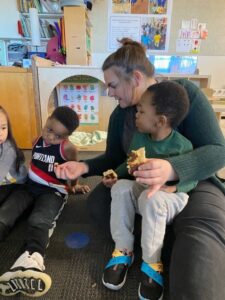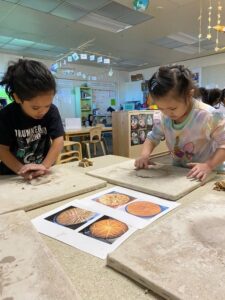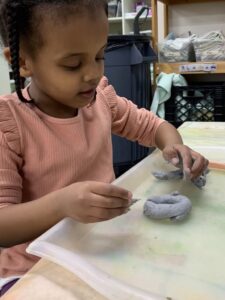
Written By Belle Chesler, TPP Studio Coach and Gabi Bizari TPP Playful Inquiry School Partner
When we take the time to slow down and really listen to children as they play, the stories they tell can become the seeds for incredible learning opportunities. Incorporating their narratives into our teaching creates opportunities for meaning-making that ultimately enriches our classrooms and brings us all closer together in community.
There are seven languages spoken in the Shaver Teaching Preschool community. Building strong cross-cultural friendships between the children has been a goal and a challenge for the Shaver teachers. By honoring the students’ stories and valuing their lived experiences, we work to build a more cohesive community based on mutual respect and shared interests.
Telling Stories with Clay:
Clay is a wonderful material to use for narrative storytelling. The forgiving nature of the clay–it can be reshaped and repurposed over and over again–allows for spontaneous innovation and collaboration, helping to make connections across language and culture.
In the art studio, I invited the children to work with a large ball of earthenware potter’s clay, encouraging them to use the clay to represent a story they’d like to tell. I purposefully didn’t put out the clay tools and instead encouraged the children to use their hands as tools to tell their stories. They’d already been introduced to clay several times throughout the year, so they were familiar with the ways that they could manipulate it by pinching and rolling, adding, and subtracting. At first, they made simple balls and snakes, chatting in multiple languages while they worked and helping one another to spray the clay with water when it felt too dry.
One student, Heiran, rolled her clay into a ball and then patted it flat with both hands. When she was satisfied with its shape, she declared, “I’m cooking! I’m making Himbasha.”
I asked her, “What is Himbasha?”
Heiran replied, “My mom made it before. It’s soooo yummy! When she puts oil on it, your hands get golden.”


Abigail shared that she’d also eaten Himbasha and exclaimed, “It’s sweet! It tastes like cake!”
The children were inspired by Heiran’s story about her mother making Himbasha. They all started making Himbasha together. As they worked, Heiran told us more about how her mother kneaded the Himbasha, demonstrating the motion with her hands.
Heiran then went to wash her hands in the buckets placed behind the studio table. As new students joined the Himbasha preparations, she stirred her hands around in the warm water, singing. “It’s strawberry soup,” she announced as she sang and stirred.


Later, more students came to work with clay, Snit who is an emerging trilingual joined in on the Himbasha preparation making connections across the table in various languages. Snit’s home language is Tigrinya, she is fluent in English and has many native Spanish speaking friends in the preschool so she has been quickly picking up simple phrases. As we sat at the table I noticed her speaking in English to me, Tinginya to Heiran and Naomi and counting the dots in Spanish with Luna.
Snit: I’m making Himbasha too!
Naomi: Himbasha has dots on it.
We’d been working on recognizing and creating patterns in our artwork, so I asked the children, “Do the dots on Himbasha make a pattern?” They answered yes, so we made dots in a pattern on our Himbasha together.
Making Connections:
During the reflection circle, teachers Danielle and Clare shared photos of the Himbasha making with the children, asking them questions to learn more about the bread and documenting their responses. Snit, Naomi, Heiran, and Abigail shared that they eat Himbasha at celebrations, birthday parties, and baby showers.
The teachers and mentor Gabi used this information as they researched Himbasha together. They were fascinated to learn that families in Ethiopia and Eritrea have a specific design to decorate their bread, and that although raisins, orange peel, and cardamom seeds are some of the most traditional ingredients added to the base recipe, ingredients change from one preparation to another. They were also excited to learn that oral storytelling traditions are celebrated in Ethiopia and Eritrea.
Together, they used their research to brainstorm possible invitations for the classroom. They chose a mentor text, Fry Bread, and planned out how they’d bring in supplemental texts like a cookbook on how to bake bread for students to look through as they wrote their own recipes and made different breads from playdough.



Invitations included:
Message Center: What is your Himbasha pattern?
Art Studio: Potter’s clay with photos of himbasha for reference and inspiration.
Sensory Table: What is the Shape of your bread?
Sensory Table 2: How do these smells make you feel? (ingredients that could be added to Himbasha for observing and smelling)


Involving Families in Classroom Learning:
Gabi shared the story of the Himbasha-making with Heiran and Naomi’s mom, and she immediately offered to make Himbasha for the group the next day. She shared that the girls love to eat Himbasha for breakfast, and she verbally shared the recipe.
On Thursday morning Heiran and Naomi were excited.
Heiran & Naomi: Teacher Gabi, we have a surprise for you, it’s on the table, come see!
Snit: My mom said she wants to make one Himbasha too!
During the morning circle, Teacher Clare showed photos of the many different types of Himbasha and mentioned that Himbasha would be the snack that day.


Later while the children were eating, the teachers asked: What does it taste like? What does it smell like?
Naomi: Like Himbasha!
Crystal: Himbasha has stuff in it
Naomi: It’s raisins, my mom puts raisins in it
Javier: Smells like pumpkins
Eileen: Smells like cupcakes
Liam: Smells like jelly inside
Heiran: Like cake
Naomi: I eat Himbasha at my birthday
Matthew: (after some encouragement to try it) Yum!


During materials explore, children took turns at the art studio making their versions of Himbasha.
Amina: I never made Himbasha before
Eileen: My mom never made me Himbasha at home. It tastes like pumpkin and cupcakes.
Crystal: I’m trying to make this pattern here (points to the picture). I need more water for the clay!
Liam: I’m making mine, I want this pattern here (points to another picture).
Crystal: Hey, we are going to make the same, Liam. I think I’ll make a different one, a flower Himbasha.
Amina: I need more water too, look at my hands.




At the sensory table, Naomi looked at recipes, while Snit worked on her Himbasha.
Naomi: I’m looking for a recipe.
Snit: Mine is not ready yet, no pictures teacher Gabi.
Heiran: I’m not done yet, I’m doing the shape.
Naomi: I can use this tool for my pattern.


Extending the Learning:
When I returned to the art studio during the next week, it was clear that we had an incredible opportunity to extend their learning. I decided that we would make celluclay food –including Himbasha– for the dramatic play kitchen. Celluclay air dries and hardens, enabling the students to use and enjoy their creations throughout the rest of the school year.
Heiran, Naomi, Javier, and Eileen joined me at the art studio to make celluclay versions of the Himbasha and other breads and cakes they’d been learning about during the last week. Each place at the table was set with a ball of celluclay on top of a large, flat tray. Communal tools were placed in a glass at the center of the table. After a week of working with the potter’s clay and playdough, they’d become much more proficient at sculpting the clay and incising patterns onto the surface of their creations.
They chanted, “We’re cooking! We’re cooking!” as they mashed the celluclay on the table and pushed it through their fingers. With excitement, Javier pointed to the flat disc he’d made on the table.
“I’m going to make a blue cake! It will be blue, pink, and green!”
Heiran chimed in. “Hot dog! I’m making a hot dog! Who wants a hot dog? Meeeee!”
They worked quietly, examining the new material, noting the stickiness and the difference between this clay and the potter’s clay. Eileen poked a hole in the middle of the ball she’d made. “I’m making a donut!” Naomi looked at Eileen’s donut and began to roll her clay in a ball as well. “Me too!” she exclaimed. After a while she flattened her ball out and made a small triangle with part of the clay. “Now I made a pizza.”


Crystal sat down at the table after Naomi left to wash her hands. “I’m making a strawberry for the kitchen.” Abigail showed everyone her playdough cake. “I made Himbasha!”
Matthew sat down to join us. He patted the celluclay with his hands. As he worked, he said, “I making Himbasha,” quietly to himself. Guidance looked around, observing his classmates. “I’m making a donut. I’m making food for me and you!”


We waited a full week for the celluclay food to dry, and when I returned to Shaver, we painted our sculptures with tempera paint. The children enjoyed mixing the paint and adding patterns to the surface of the sculptures.
After all the sculptures were painted, we looked for a special container to display them in. The basket we found was too cramped, so we decided on a large platter. We placed the platter on the kitchen table in the dramatic play area, making the sculptures available for use by all the children in the classroom.

The food sculptures have become an important part of the children’s dramatic play. This area of the classroom is now a favorite place for the children to be in community and make connections with one another. The sculptures recontextualized their play and expanded possibilities for trying on different roles with familiar materials.



And the Story Continues…
While playing in small world and touching white sand, Heiran pretended to pour liquid from cup to cup. “I’m making Bun and Shahee. Bun is for drinking, and Shahee is made out of sugar, a lot of sugar”. Hinari chimed in, “I have tea at home too”.
Naomi joined Heiran and Hinari. “Let me explain, Bun is a drink, Shahee is a drink too, it’s tea”.


Following their lead, a Bun and Shahee station was created for the students at the sensory table, and it’s become a popular place to share tea and a story.
By embracing the stories children share through their play and creative expression, we unlock powerful opportunities for connection and growth. As educators, when we actively listen, document, and celebrate the voices of children, we lay the groundwork for a community that values respect, diversity, and collaboration. In doing so, we not only honor their individuality but also weave their unique narratives into the fabric of a learning community.
What are the possibilities for learning when children see authentic representations of themselves in the classroom?